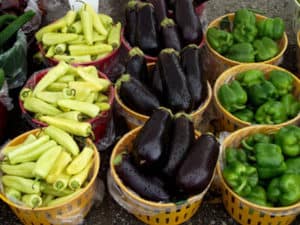Minimize pest and disease damage with beneficial growing practices
Pests and diseases are responsible for millions of dollars in damages to vegetable crops each year. At the same time, the push towards reducing the use of pesticides and fungicides is growing stronger. Several beneficial cultural practices can meet both demands, helping with pest and disease control and minimizing the use of toxic chemicals.
 Disease resistant varieties should be used whenever possible. This is a simple, cost-effective practice that is especially useful in areas where disease is already prevalent or soils are infected. Remember that disease resistant labeling is not a guarantee that the plant is impervious to all invading pathogens. For instance, some tomato cultivars are resistant to fungal diseases such as Verticillium and Fusarium, but they are not resistant to foliar diseases such as leaf blight and gray leaf spot.
Disease resistant varieties should be used whenever possible. This is a simple, cost-effective practice that is especially useful in areas where disease is already prevalent or soils are infected. Remember that disease resistant labeling is not a guarantee that the plant is impervious to all invading pathogens. For instance, some tomato cultivars are resistant to fungal diseases such as Verticillium and Fusarium, but they are not resistant to foliar diseases such as leaf blight and gray leaf spot.
Crop rotation changes the planting sequence of crops grown on the same plot of land from year to year. Rotating crops from a different genus or species breaks pest cycles, controls weeds, recycles nutrients, and improves soil tilth and fertility. Green manure cover crops (GMCCs), such as cowpeas, soybeans, and millet, are often used for rotations because they help with soil erosion and increase soil fertility. Disease resistant crops are also a good choice. Rotating tomatoes with broccoli or mustard to control Verticillium wilt is an example of crop rotation for disease control.
Sanitation is the simple practice of removing anything that might be a host to disease or insects. This includes getting rid of dead and diseased plant material, removing crop residues, controlling standing water (e.g., puddles, low-spots) and removing weeds and other field trash. Sanitizing equipment should be a priority in order to avoid passing on pathogens and foodborne illnesses. In 2011, an outbreak of Listeria bacteria (Listeria monocytogenes) in Colorado resulted in over 100 sick people and 25 deaths. The outbreak was caused by dirty equipment in a cantaloupe packing plant.
Eradication follows along the same lines as sanitation. Burn noxious weeds and diseased plant materials instead of incorporating them back into the soil or putting them in the compost bin.
Irrigation should be avoided late in the evening as wet foliage encourages pathogens. Applying irrigation water to the soil, rather than to the foliage, helps minimize problems. Overwatering can lead to stem and rot diseases.
Prevention is always a good policy. Purchase plants, seeds, and media from reputable sources and make sure everything is certified as weed-free. Install screens on irrigation intake lines to bar the entry of weed seeds. Fill in low spots and potholes, anyplace where standing water can accumulate.
Scouting is an integral part of any IPM program. Regularly monitor crops for diseases, insects, noxious weeds and nutrient deficiencies.
Fertilize properly. Healthy plants are more tolerant of pests and diseases than weak ones. Proper nutrition ensures that plants have strong immune systems that are ready to respond aggressively in times of need. A well-balanced nutrition program is a good preventative measure, addressing problems before they become problems.
KeyPlex offers a wide range of highly effective plant nutrition products for crops such as tomatoes, potatoes, carrots, cole crops and more.
